Geology
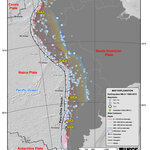
A long lasting foreshock series controlled the rupture process of this year's great earthquake near Iquique in northern Chile, according to an international research team
The earthquake was heralded by a three quarter year long foreshock series of ever increasing magnitudes culminating in a Mw 6.7 event two weeks before the mainshock.
The mainshock (magnitude 8.2) finally broke, on April 1st, a central piece out of the most important seismic gap along the South American subduction zone. The study reveals that the Iquique earthquake occurred in a region where the two colliding tectonic plates…

The biggest mystery in the mid-east is why countries of one religion won't put the country of another religion on any geographical maps in any of its schools, but the second biggest mystery is why many of the oldest parts of Jerusalem's Western Wall look like they could have been placed yesterday.
The Western Wall is a remnant of the ancient wall that surrounded the courtyard of the Jewish Temple in Jerusalem. It is located in Jerusalem's Old City at the foot of the Temple Mount.
Some of its stones are extremely eroded, that is why people can place prayer notes in the wall's cracks and…
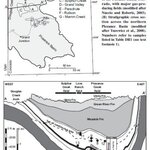
Hydraulic fracturing is in the news because more natural gas has meant substantially fewer carbon emissions - and it has also been implicated in a variety of environmental issues.
Man is doing what nature has always done, albeit on a different time scale. A new GSA BULLETIN study examines how long it takes natural Earth processes to form hydraulic fractures and whether the formation is driven by sediment compaction, oil and gas generation or something else. Plus, in order to make environmental models about modern hydraulic fracturing production, it's important to know what role…

A new study has found that more than 75 percent of the water loss in the drought-stricken Colorado River Basin since late 2004 came from underground resources., which means the extent of groundwater loss may pose a greater threat to the water supply of the western United States than previously thought.
This study is the first to quantify the amount that groundwater contributes to the water needs of western states. According to the U.S. Bureau of Reclamation, the federal water management agency, the basin has been suffering from prolonged, severe drought since 2000 and has experienced the…

A new study suggests that Saharan dust played a major role in the formation of the Bahamas islands. Researchers from the University of Miami (UM) Rosenstiel School of Marine and Atmospheric Science showed that iron-rich Saharan dust provides the nutrients necessary for specialized bacteria to produce the island chain's carbonate-based foundation.
UM Rosenstiel School Lewis G. Weeks Professor Peter Swart and colleagues analyzed the concentrations of two trace elements characteristic of atmospheric dust – iron and manganese – in 270 seafloor samples collected along the Great Bahama Bank over a…

In Jeju, a place emerging as a world-famous vacation spot with natural tourism resources, a recent study revealed a volcanic eruption occurred on the island. The Korea Institute of Geoscience and Mineral Resources (KIGAM) indicated that there are the traces that indicated that a recent volcanic eruption was evident 5,000 years ago.
That is the first time to actually find out the date when lava spewed out of a volcano 5,000 years ago in the inland part of the island as well as the one the whole peninsula.
The research team led by Dr. Jin-Young Lee confirmed in results from radiocarbon dating…
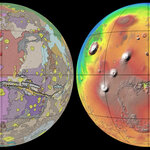
A new global geologic map of Mars is the most thorough representation of the "Red Planet's" surface, bringing together observations and scientific findings from four orbiting spacecraft that have been acquiring data for more than 16 years.
Mars is the solar system’s most Earth-like planet and the only other one in our Sun’s “habitable zone.” The U.S. Geological Survey-led mapping effort reveals that the Martian surface is generally older than previously thought. Three times as much surface area dates to the first major geologic time period - the Early Noachian Epoch - than was…
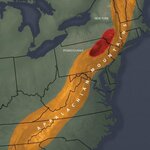
The Appalachian mountain chain runs along a nearly straight line from Alabama to Newfoundland— 1,500 miles - except for a curious bend in Pennsylvania and New York.
Why it bends has been a mystery. When the North American and African continental plates collided more than 300 million years ago, the North American plate began folding and thrusting upwards as it was pushed westward into the dense underground rock structure—in what is now the northeastern United States. The dense rock created a barricade, forcing the Appalachian mountain range to spring up. Yet the bend was cause for…

Volcanic hazards aren't limited to eruptions, debris landslides can also cause a great deal of damage and loss of life.
Stratovolcanoes, with their steep, conical shapes made up of lava and unconsolidated mixed materials, can reach a critical point of instability when they overgrow their flanks. This leads to partial collapse, and the product of this slope failure is a large-scale, rapid mass movement known as a catastrophic landslide or debris avalanche.
In a matter of minutes, a debris avalanche can drastically modify the shape and nature of the surrounding landscape, covering…
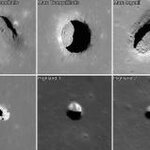
The moon's surface has by millions of craters but it also has over 200 holes – and those steep-walled pits that in some cases might lead to caves that future astronauts could explore and use for shelter, according to new observations from NASA's Lunar Reconnaissance Orbiter (LRO) spacecraft.
The pits range in size from about 5 yards across to around 1,000 in diameter, and three of them were first identified using images from the Japanese Kaguya spacecraft. Hundreds more were found using a new computer algorithm that automatically scanned thousands of high-resolution images of the lunar…